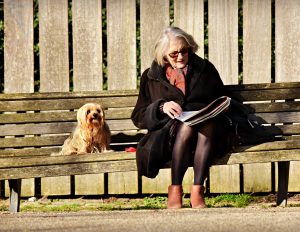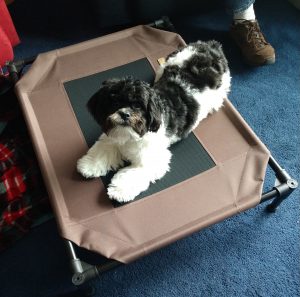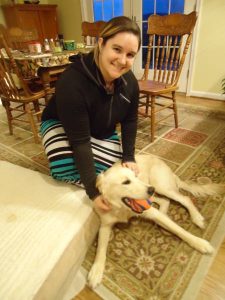As people, we value downtime. Sitting on the couch to watch the big game, laying in bed and reading a book, waking up early to sip coffee and browse the news.
 We work hard to rest hard. And although society may not value downtime as much as it should, we as individuals crave that moment when we can sit back and turn off our minds for a bit.
We work hard to rest hard. And although society may not value downtime as much as it should, we as individuals crave that moment when we can sit back and turn off our minds for a bit.
Yet so many dog owners don’t consider this for their dogs. I work with many clients who struggle with dogs that are going 24/7; dogs that don’t have an ‘off’ switch.
They chew up their toys and anything else they can get their mouths on. In the backyard, they dig hole after hole. They lick themselves raw, chew their nails to bleeding, and chase their tails like they’re hunting a squirrel. At the drop of a hat, they whine, bark, pant, and pace.
Most owners with these issues are at a loss, saying, “It’s not like he doesn’t get exercise. We take him out for a 5-mile walk every day, we play fetch with him for an hour, we let him out in the backyard to run all day. Why isn’t he tired?”
Physically, maybe he is. But mentally, your dog is going a mile a minute and he doesn’t know how to stop.
Balancing Physical and Mental Exercise
Typically, behavioral issues like those described (and yes, they are behavioral issues) are not caused by a lack of physical exercise. It’s a lack of mental stimulation.
Dogs, just like people, need more than physical stimulation to be happy. We all need mental stimulation as well. Ask yourself:
- Is that 5-mile dog walk structured and at a controlled pace, or is your dog at the end of the lead pulling and sniffing whatever it wants?
- Do you add structure to your fetch time, asking for commands before throwing the ball? Do you practice impulse control and ask your dog not to go after the ball at times?
- When you let your dog out in the backyard, do you go with him? Or is he just running in circles, digging holes, and chasing squirrels alone?
All of these activities may be physically draining, but without structured, mental guidance, they are not burning that mental energy your dog has pent up inside his head.
The Treadmill Routine
Imagine going to the gym and getting on the treadmill.
You don’t set a pace. You let your posture slouch and your mind wander instead of focusing on the activity at hand. What is going to happen? You end up on that treadmill for two hours without ever getting tired.
But if you set your pace high, keep your muscles taut, and focus on what you’re doing, you’ll be tired in 30 minutes.

You have to give your dog that same perspective when exercising. Providing your dog with structure and focus during stimulating activities (set rules to follow, set the pace, determine when you take a break) will reduce the time you have to spend exercising and increase the quality of exercise your dog gets. It turns your activity into both a physical and mental exercise.
Remember, your goal in exercising should not be to exhaust your dog. Your goal is to have a happy, healthy dog. That means you need to provide your dog with both exercise and rest. Just as you need to give your dog direction on how to physically and mentally exercise, you need to also teach them how to physically and mentally rest. You need to train your dog to have an ‘off’ switch.
The Value of the ‘Off’ Switch
The ‘off’ switch for a dog is very similar to meditation for people. It resets the mind and relaxes the body.
Most dogs are not bred to have natural ‘off’ switches. They live to work, typically on jobs that take hours of concentration and focus on the owner’s commands. This work mentally and physically stimulates dogs until they are tired, so when work is over they can value ‘off’ time.
 When a dog is not given this kind of direction throughout his day, he is left lost and bored. So he fills his own time with arbitrary activities and self-appointed jobs like:
When a dog is not given this kind of direction throughout his day, he is left lost and bored. So he fills his own time with arbitrary activities and self-appointed jobs like:
- Chewing on shoes
- Destroying furniture
- Pacing
- Guarding toys
- Chasing his tail
At first, these are just temporary outlets for that energy, but over time, these activities become ingrained. We would call it an obsessive compulsion, but what is really happening is a rudimentary cause and effect in the dog’s brain.
Cause and Effect Behavior
This is how all behaviors work for dogs.
Event/Trigger = Behavior
If the behavior the dog commits to is in some way rewarding, he is more likely to repeat it later on. Eventually that cause and effect is absolute in the dog’s mind, leading him to always commit to that behavior in a given circumstance.
 In the case of a dog learning to sit, he learns through cause and effect. If his butt hits the floor when he hears ‘Sit’, he will be rewarded with something valuable to him. In the same way, a dog that is fearful of people may growl or show teeth at the sign of a stranger. If the stranger backs away or the owner of the dog picks him up and leaves, the dog is being rewarded by getting what it wanted, to run away from the stranger.
In the case of a dog learning to sit, he learns through cause and effect. If his butt hits the floor when he hears ‘Sit’, he will be rewarded with something valuable to him. In the same way, a dog that is fearful of people may growl or show teeth at the sign of a stranger. If the stranger backs away or the owner of the dog picks him up and leaves, the dog is being rewarded by getting what it wanted, to run away from the stranger.
In the case of compulsive behaviors, even though some of these behaviors are not enjoyable (and at times, may even result in punishment), the dog is burning that energy it can’t let out any other way. This is rewarding enough for the dog to overcome most negative side effects.
The Importance of Structure
For a dog like this, the ‘off’ switch is a big piece of a vital puzzle of training. Compulsive obsessive dogs develop their behaviors primarily due to a lack of external structure. Establishing structure in the dog’s life sets him up to trust and respect that structure and the person who reinforces it. This means giving the dog purpose and direction in all of his activities. You decide when, where, and how he:
- Eats
- Plays
- Walks
- Relaxes
The more you provide this kind of structure, the more your dog will want to follow that structure on his own. That includes turning himself ‘off’ when he gets into a state that would normally lead to that compulsive behavior.
Installing the ‘Off’ Switch
There are two activities for you dog that I consider the ‘off’ switches of dog training. We’ll go over each of them in detail here.
Sit on the Dog
‘Sit on the dog’ is a seemingly passive activity you can do with your dog. I consider it a group meditation with your dog.
 The process is simple. Put your dog on a slip lead or prong collar and leash. With as little verbal direction as possible, put your dog into a down next to your feet. Put the lead under your foot, so that your dog has no tension on the lead so long as he stays with his head down on the floor. If your dog tries to get you, he will create tension on the lead until he goes back into a down.
The process is simple. Put your dog on a slip lead or prong collar and leash. With as little verbal direction as possible, put your dog into a down next to your feet. Put the lead under your foot, so that your dog has no tension on the lead so long as he stays with his head down on the floor. If your dog tries to get you, he will create tension on the lead until he goes back into a down.
Now just sit there and be. Let the world go by. Put on an audiobook or some smooth jazz or nothing at all. Just be there with your dog for a few minutes to a couple hours, however long you want.
A Note on Execution of Sit on the Dog
A quick note, a simple process doesn’t make it simple to implement. The more high-strung your dog, or the more distrustful he is, the more your dog will struggle with this activity at first. He or she may struggle against the lead, not knowing that you are asking for a down, or not being able to maintain it for a length of time because he or she does not yet know how to turn off.
It is imperative that you calmly accept and wait through any protest your dog may give. The first few times, you may want to give your dog a down command if he knows it, just to help him along. But this isn’t a down exercise, it’s a turning ‘off’ exercise. You need to be patient, calm, and persistent to help your dog through this process and make ‘sit on the dog’ a calming experience over time.
‘Place’ Command
While ‘sit on the dog’ is a shared activity between you and your dog, a solid ‘place’ command is your opportunity to trigger your dog’s ‘off’ switch on command. I consider ‘place’ to be one of the most important commands your dog can ever learn.
A good place command looks like this – a dog laying in a specific spot calmly regardless of what is happening around him. At first, you’ll teach a place command at home where there are few distractions. Then you will add controlled distractions. Drop food on the floor, vacuum the house, or invite friends over to ring the doorbell and be let in. Over time, you can apply that command anywhere, at any time, just like any other command.
 Once place becomes a routine aspect of your dog’s life, he will begin to value the state of mind it encourages. You can then start layering it with triggers to replace bad behaviors.
Once place becomes a routine aspect of your dog’s life, he will begin to value the state of mind it encourages. You can then start layering it with triggers to replace bad behaviors.
For instance, my favorite use of place is when guests arrive at your home. Once your dog knows a place command, you can turn your doorbell or the sound of knocking at the door into a place command. This means your dog will place at the sound of the knock or doorbell, so you can bring your guests in without interruption. It also gives you full control of if and when your dog meets guests.
Your dog may even choose to place himself when he’s overstimulated. The feeling of being placed will become rewarding on its own, leading your dog to want to turn off for his own benefit. It is truly a universally beneficial command to teach your dog.
A Note on Elevated Cot Beds
 I always recommend getting an elevated cot bed to train a place command. Not only is it comfortable for your dog to lay on, it makes ‘place’ more distinguishable from the floor. Additionally, many of the dogs I train have self-confidence and trust issues, making them anxious and alert at all times. Getting up on an elevated object that the dog is not familiar with is a great confidence and trust-building exercise for dog and owner.
I always recommend getting an elevated cot bed to train a place command. Not only is it comfortable for your dog to lay on, it makes ‘place’ more distinguishable from the floor. Additionally, many of the dogs I train have self-confidence and trust issues, making them anxious and alert at all times. Getting up on an elevated object that the dog is not familiar with is a great confidence and trust-building exercise for dog and owner.
The process for creating a solid place command has a few steps. You can learn more about teaching a place command and proofing it for any situation in a later article.
Final Thoughts
We all know what it feels like to be overwhelmed, running a mile a minute. We value the time when we can stop the momentum and just be in the moment.
Our dogs deserve to know and enjoy that feeling as well. Instead of giving your dog another toy to chew on or yelling at him for getting into the trash yet again, give your dog something more. Train your dog to have an ‘off’ switch, and not only will he be happier, the foundation of your relationship will be stronger for it.
—
If you live in the central PA area (York, Lancaster, Harrisburg) and would like help teaching your dog to turn ‘off’, email me at virginia@ghdogs.com or shoot me a text at 717-814-8527. You can also review my package options and book a free phone consultation here.


